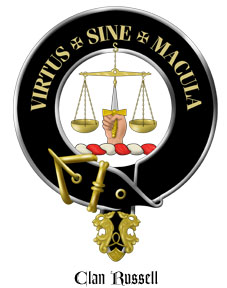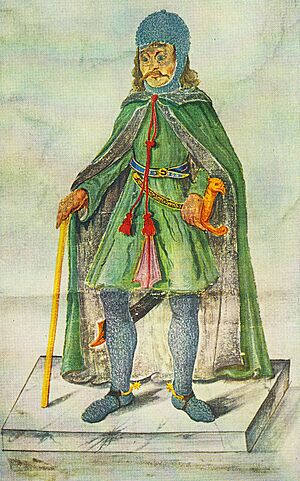Clan Russell facts for kids
Quick facts for kids Clan Russell |
|
|---|---|
| Ruiseal | |

Crest: A dexter hand holding a skene dubh and on the point thereof a pair of balances, all Proper.
|
|
| Motto | Virtus sine macula. (Virtue without a stain) |
| Profile | |
| Region | Lowlands and Highlands |
| District | Perth and Kinross, Clackmannanshire and Aberdeenshire |
| Clan Russell has no chief, and is an armigerous clan | |
| Historic seat | Aden in Aberdeenshire, various other locations in Scotland |
| Last Chief | Baron Rozel |
Clan Russell is a Scottish clan with its own coat of arms. The clan is believed to have started in Normandy, a region in France. The Russells have family connections to the English Dukes of Bedford. Many people with Russell family ties live in Great Britain and America today.
Contents
The Story of Clan Russell
Where Did the Russells Come From?
Some people think the name Russell comes from the French word roux, which means red. Others believe it comes from a place in Normandy called de Rosel. The name Rufus, meaning "red-haired," was also common among early Normans.
Records show a Walter Russel in Scotland between 1164 and 1177. He witnessed an important document for Paisley Abbey. Around 1180, a John, son of Robert Russell, is mentioned. In 1259, Robert Russell witnessed another important paper about land.
Russells and the Wars for Scottish Freedom
In 1296, a Robert Russell signed the Ragman Rolls. This document showed his loyalty to Edward I of England.
Historian William Anderson wrote that the Russell name came to Aberdeenshire with a baron named Rozel. This English baron fought in the siege of Berwick and the Battle of Halidon Hill in 1333. After these battles, Rozel settled in Scotland. He gained land called Aden, and his family became known as 'Russell of that Ilk'.
Important Russells Through the Centuries
In 1680, Patrick Russell bought land in Banffshire. His descendants became the Scottish Barons of Aden in Aberdeenshire.
The Russell family of Ashiesteel in Selkirkshire had many brave soldiers. Colonel William Russel of Ashiesteel was a top army officer in Madras, India, from 1756 to 1767. He served under General Lord Clive. His son, Major General Sir James Russel, also served in India. He led a group of cavalry soldiers at the Battle of Mahidpur.
Alexander Russell was a famous doctor and expert in nature. In 1756, he wrote a book called Natural History of Aleppo.
In England, another branch of the Russell family became the Dukes of Bedford. John Russell was the third son of the sixth Duke. He studied at the University of Edinburgh in Scotland. He admired the Scottish ideas of independence and democracy. In politics, he helped create the first Reform Act 1832. This law changed how people voted in Britain. He also served as Prime Minister of the United Kingdom. In 1861, he was given the title Earl Russell. His grandson was Bertrand Russell, a very important thinker of the 1900s.
Russell Family Homes and Castles
- Ashiesteel House: This mansion is near Galashiels in the Scottish Borders. It includes a tower house from the 1600s. The Russells owned it, and later, famous writer Sir Walter Scott lived there. He wrote some of his books at Ashiesteel.
- Banff Castle: This castle near Banff, Aberdeenshire was first owned by the Clan Comyn. It later belonged to the Sharps and then the Russells. Not much of the old castle remains. A new mansion was built there in the 1700s.
- Montcoffer House: This mansion is near Banff and dates back to 1670. The Russells sold it in 1750. It was updated in 1825.
- Aden House: This mansion is near Peterhead in Aberdeenshire. It is now a ruined building from 1832. This building replaced an older castle. The Russells sold the house and most of the land in 1937. Some say a ghost of one of the previous owners' daughters haunts it.
- Blackhall Castle: This was a strong castle near Banchory in Aberdeenshire. Nothing remains of it today. The Russells once held it, and then it passed to the Clan Hay.


